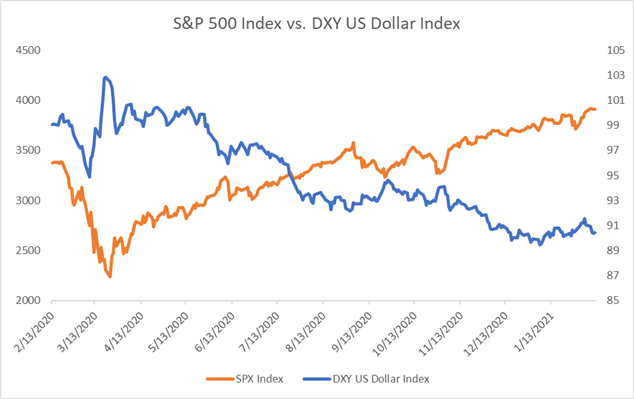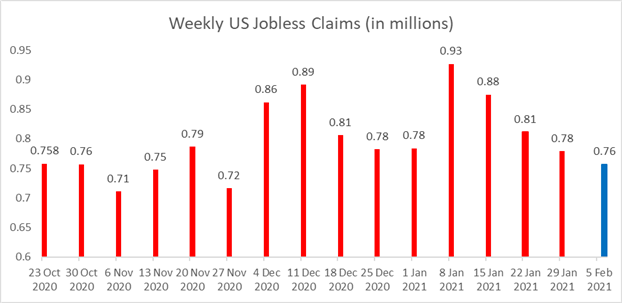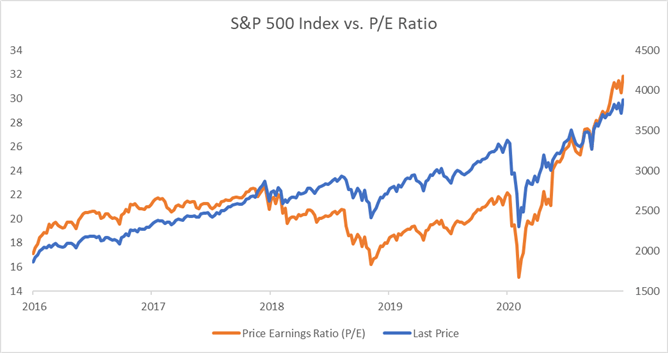S&P 500 May Extend Rally On Stimulus Hopes And A Weaker US Dollar
S&P 500 FUNDAMENTAL FORECAST: BULLISH
- US stocks may rise amid strong earnings, vaccine rollouts, and fiscal stimulus hopes.
- A weakening US Dollar and lower Treasury yields may alleviate pressure on risk assets.
- The S&P 500 index is trading around a 31.9 price-to-earnings (P/E) ratio, far above its five-year average.
Global stocks seem to be back to a ‘risk on’ mode after a brief pullback seen at the end of January. Investor confidence appeared to be revitalized by stimulus hopes, a retreat in the US Dollar, as well as strong Q4 corporate earnings. US lawmakers are working towards approving President Joe Biden’s US$ 1.9 trillion fiscal stimulus bill, which led to rising reflation hopes – expectations that demand and output will pick up with the help of aggressive fiscal spending.
The DXY US Dollar index and the S&P 500 index tend to exhibit a negative relationship, with the past 12-month correlation coefficient standing at -0.912 (chart below). This suggests that the fundamental forces pulling the Greenback away from recent highs may also alleviate downside pressure in the S&P 500 index.
In 2018, over 40% of sales in S&P 500 companies came from overseas, according to S&P Global. Thus, a weaker US Dollar may boost overseas sales by making them relatively cheaper when foreign exchange differences are taken into consideration. For emerging markets, a softer USD may also encourage capital inflows and thus buoy asset prices.
Source: Bloomberg, DailyFX
On the fundamental side, an improving recovery outlook and robust Q4 corporate earnings may continue to support equity prices. This is as the job market shows signs of improvement, with the vaccine rollouts helping to bring down daily COVID-19 infections rapidly over the past few weeks. Weekly jobless claims have declined since early January, reflecting an improvement in labor market sentiment (chart below).
Meanwhile, Fed Chair Jerome Powell addressed the need for accommodative monetary policy because the US job market is far from a full recovery. This pointed to an extension of the current accommodative monetary environment. Against this backdrop, investors may be incentivized to park their cash in riskier assets when looking for better yields and portfolio growth.
Source: Bloomberg, DailyFX
Q4 US corporate earnings delivered strong prints so far, with nearly 70% of S&P 500 companies having already released their results. Among those, 83% have beaten market expectations with an average positive earnings surprise of 22.8%. Big tech companies and banks contributed most to earnings growth, while the energy sector lagged.
Encouragingly, more companies are issuing positive EPS guidance for Q1 2021, showing that business decision makers are more optimistic about the recovery outlook, and are probably more willing to expand capital expenditures in the months to come.
Valuation-wise, the S&P 500 index is trading around a 31.9 price-to-earnings (P/E) ratio, which is the highest level seen in two decades. This is also more than 50% above its five-year average of 21.2. Rich valuations may render the index vulnerable to profit-taking should rising yields and unexpected events hinder stock markets from reaching higher highs.
S&P 500 INDEX VS. P/E RATIO – FIVE YEARS
Source: Bloomberg, DailyFX
Disclosure: See the full disclosure for DailyFX here.






